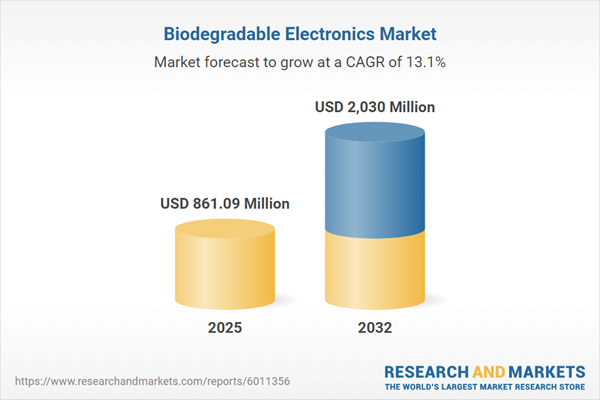Speak directly to the analyst to clarify any post sales queries you may have.
Biodegradable electronics are rapidly reshaping sustainability strategies for enterprises, delivering innovative approaches for regulatory compliance and operational agility. As organizations address evolving environmental expectations, these solutions are driving measurable progress across critical business functions.
Market Snapshot: Biodegradable Electronics Market Overview
The biodegradable electronics market is demonstrating significant global traction, having reached a value of USD 762.10 million in 2024 and recording a compound annual growth rate (CAGR) of 13.08%. Deployment of these technologies is accelerating in response to demand for sustainable practices and stricter environmental regulations. Enterprises across automotive, healthcare, and smart packaging are integrating biodegradable electronics to reinforce circular economy principles and address compliance risks. The market’s progression reflects a notable shift as forward-looking organizations capitalize on increased readiness for eco-friendly solutions, enabling them to refine competitive positioning through the integration of sustainability into core operations.
Scope & Segmentation of the Biodegradable Electronics Market
This report equips senior leaders with robust market intelligence for strategic decisions in the biodegradable electronics space. The following segments structure the market to guide effective resource allocation and targeted growth:
- Product Types: Biodegradable batteries, displays, RFID tags, sensors, and transistors facilitate end-to-end sustainability within product development and manufacturing processes.
- Application Sectors: Automotive electronics, integrated sensors, smart packaging, diagnostic devices, logistics, advanced medical technologies, consumer goods, and tracking systems enable enterprises to differentiate offerings and capture emerging market share.
- End-User Industries: Automotive, healthcare, packaging, logistics, diagnostics, supply chain management, consumer electronics, and residential segments provide diverse points of market entry and supply optimization.
- Technology Platforms: Organic electronics, printed and thin-film platforms, and transient electronics offer customizable solutions for operational resilience, compliance management, and cost efficiency.
- Material Categories: Composites, metals, polymers, and silicon inform device durability and sourcing strategies, influencing procurement and design outcomes.
- Regional Markets: The Americas, Europe, Middle East & Africa, and Asia-Pacific each present unique regulatory demands and expansion opportunities, supporting localization and compliance initiatives.
- Key Industry Players: Leading contributors such as NatureWorks LLC, Stora Enso Oyj, PragmatIC Semiconductor Limited, Polymateria Ltd, FlexEnable Limited, and Novamem AG advance technology adoption and ecosystem growth through continuous innovation.
Key Takeaways for Senior Decision-Makers
- Adopting biodegradable substrates strengthens ESG credentials, addressing growing stakeholder expectations and helping organizations manage long-term environmental responsibilities.
- Flexible designs and modular manufacturing enable businesses to adapt rapidly to evolving regulations and market shifts, securing strategic operational advantages.
- Dissolvable sensors and transient components raise standards in diagnostic accuracy and environmental monitoring for sectors prioritizing traceability and compliance.
- Regionalized supply chain models reduce exposure to global market uncertainties, bolstering risk management and continuity planning during disruptions.
- Fostering collaboration across material science, engineering, and technology fields accelerates the adoption of sustainable innovations, propelling companies toward commercialization milestones.
- Enhancing internal expertise and cultivating strategic partnerships position enterprises for swift technological integration and reinforce competitiveness within dynamic markets.
Tariff Impact: Adjusting Strategy in a Shifting Policy Landscape
Recent changes in United States tariff policies are prompting enterprises to reconfigure manufacturing strategies, moving toward more localized and regional production. These adjustments reshape supply networks, increasing the necessity for compliance-centered operations. As regulatory obligations and operational costs rise in this shifting landscape, adaptable sourcing becomes critical for safeguarding innovation pipelines and maintaining business continuity despite regulatory volatility.
Methodology & Data Sources
This analysis draws on secondary market research, direct industry expert engagement, and on-site validations at production facilities. This approach provides a comprehensive view of industry trends, adoption patterns, and the regulatory context shaping the biodegradable electronics market.
Why This Report Matters: Executive Summary for Senior Leaders
- Delivers actionable insights and metrics, enabling leaders to advance sustainability programs while adapting to the fast-evolving global electronics sector.
- Arms enterprises with intelligence on geographic regulatory trends and tariff changes, improving supply chain responsiveness and operational resilience.
- Presents frameworks for aligning business strategies with ESG standards, supporting innovation-driven differentiation and responsible market leadership.
Conclusion
This report provides practical guidance for organizations transitioning to sustainable electronics, supporting collaboration and agility as sector innovation and compliance trends continue to reshape industry dynamics.
Additional Product Information:
- Purchase of this report includes 1 year online access with quarterly updates.
- This report can be updated on request. Please contact our Customer Experience team using the Ask a Question widget on our website.
Table of Contents
3. Executive Summary
4. Market Overview
7. Cumulative Impact of Artificial Intelligence 2025
Companies Mentioned
The companies profiled in this Biodegradable Electronics market report include:- NatureWorks LLC
- Stora Enso Oyj
- PragmatIC Semiconductor Limited
- Polymateria Ltd
- FlexEnable Limited
- Novamem AG
Table Information
| Report Attribute | Details |
|---|---|
| No. of Pages | 191 |
| Published | October 2025 |
| Forecast Period | 2025 - 2032 |
| Estimated Market Value ( USD | $ 861.09 Million |
| Forecasted Market Value ( USD | $ 2030 Million |
| Compound Annual Growth Rate | 13.0% |
| Regions Covered | Global |
| No. of Companies Mentioned | 7 |








